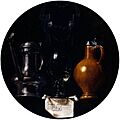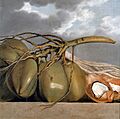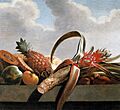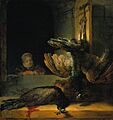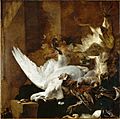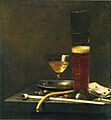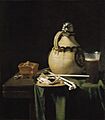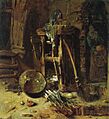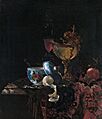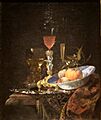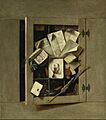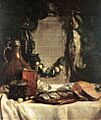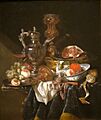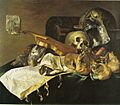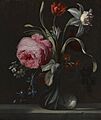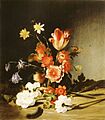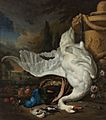Still Life Paintings from the Netherlands 1550–1720 (in Dutch, Het Nederlandse Stilleven 1550–1720) was a special art exhibition. It took place in 1999 and 2000 at two famous museums: the Rijksmuseum Amsterdam in the Netherlands and the Cleveland Museum of Art in the United States. This exhibition showed how Dutch artists painted everyday objects, food, and flowers over many years.
The exhibition featured 80 amazing paintings. These artworks helped people understand the different kinds of still life art popular in the Netherlands during that time. Artists painted things like food in a kitchen, beautiful flowers, tasty breakfasts, and even objects that reminded people about life and time.
What is Still Life Painting?
Still life painting is a type of art where artists draw or paint objects that don't move. These objects can be anything from fruit and flowers to books, musical instruments, or even dead animals. Artists arrange these items carefully to create an interesting picture.
Why Did Artists Paint Still Life?
In the Netherlands, especially during the 16th and 17th centuries, still life paintings became very popular. They weren't just pretty pictures. Many of these paintings had hidden meanings or told a story. They could show off wealth, remind people to be humble, or simply celebrate the beauty of nature.
Types of Dutch Still Life Paintings
Dutch artists were masters of still life. They developed several popular styles, each with its own special focus. Let's explore some of these interesting types.
Kitchen and Market Scenes
These paintings, sometimes called kitchen pieces (keukenstuk), showed bustling kitchens or busy market stalls. They were filled with food like meat, fish, and vegetables. Often, these scenes included people, sometimes even showing religious stories happening in the background.
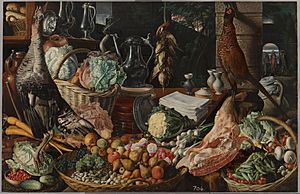
Kitchen scene with Christ at Emmaus by Joachim Beuckelaer, around 1560. Can you spot the story of Christ in the background?
Fruit and Floral Still Life
Artists loved to paint colorful arrangements of fruit (fruitstuk) and flowers (blommetje). These paintings often showed off the artist's skill in capturing tiny details, like dewdrops on petals or the texture of a grape. They also celebrated the beauty and variety of nature.
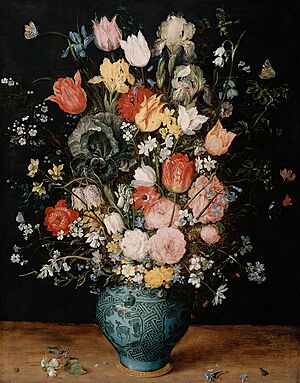
Chinese porcelain vase of flowers on a tabletop by Jan Brueghel the Elder, 1609. Notice the detailed flowers and the fancy vase.

Flowers in a Glass by Ambrosius Bosschaert, 1606. This painting shows a beautiful bouquet in a simple glass.

Still Life with Flowers, Shells, and Insects by Balthasar van der Ast, around 1635. Look closely for the tiny insects!
Breakfast Pieces
Breakfast pieces (ontbijtje) were paintings that showed simple meals laid out on a table. These often included bread, cheese, herring, and drinks like beer or wine. They were a chance for artists to show off their ability to paint different textures, like crusty bread or shiny glass.

Breakfast Piece by Pieter Claesz, 1636. A simple meal, but painted with great detail.
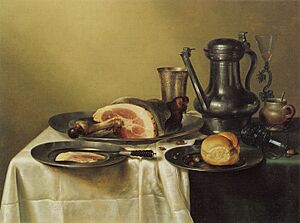
Laid Table with Ham and a Roll by Willem Claeszoon Heda, 1635. Heda was famous for his elegant breakfast scenes.
Vanitas Paintings
Vanitas paintings were a special kind of still life that reminded people about how short life is and how worldly things don't last forever. They often included symbols like skulls, hourglasses, snuffed-out candles, or wilting flowers. These objects encouraged viewers to think about deeper meanings.
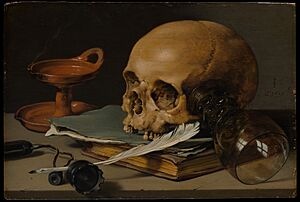
Still Life with a Skull and a Writing Quill by Pieter Claesz, 1628. The skull is a classic symbol in vanitas art.
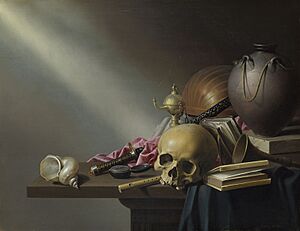
Still life: An Allegory of the Vanities of Human Life by Harmen Steenwijck, around 1640. This painting is full of symbols about life and time.
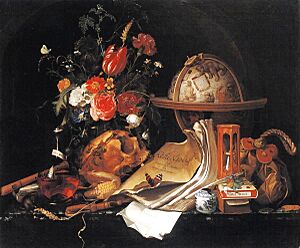
Vanitas still life by Maria van Oosterwijck, 1668. Another example by a female artist, showing common vanitas objects.
Hunting Pieces and Show Pieces
Hunting pieces (jaagstuk) displayed dead game, like birds or rabbits, often alongside hunting tools. These showed off the success of a hunt. Show pieces (pronkstilleven) were grander paintings that featured expensive and fancy objects, like silver cups, exotic fruits, and rich fabrics, to show wealth and luxury.
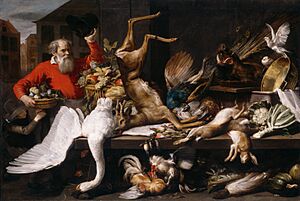
Still Life with Dead Game, Fruits, and Vegetables in a Market by Frans Snyders, 1614. Snyders was known for his large, detailed market scenes.

Still Life with Silver Ewer by Willem Kalf, 1656. This is a great example of a "show piece" with its luxurious items.
Famous Still Life Artists
Many artists became famous for their still life paintings. Some specialized in certain types, while others explored many different styles.
Early Masters
Artists like Pieter Aertsen and Joachim Beuckelaer were among the first to create large kitchen and market scenes. They often combined everyday life with religious stories. Jan Brueghel the Elder and Ambrosius Bosschaert were pioneers in painting beautiful, detailed flower bouquets.
Golden Age Painters
During the Dutch Golden Age (roughly the 17th century), artists like Willem Claesz. Heda and Pieter Claesz became known for their "breakfast pieces" and "vanitas" paintings. They were masters at showing light reflecting on different surfaces. Jan Davidsz. de Heem created rich and abundant still life paintings, often combining fruits, flowers, and luxurious objects.
Later Artists
Later artists, such as Willem Kalf, continued to paint magnificent "show pieces" with gleaming silver and glass. Maria van Oosterwijck and Rachel Ruysch were important female artists who excelled at painting intricate floral still life, showing incredible detail and vibrant colors.
Images for kids
-
Garland of Flowers around an Allegory of Farming by Jan Brueghel the Elder, 1615
-
Flowers in a Glass in a Niche by Roelant Savery, 1611
-
Still Life with Flowers in a Vase by Christoffel van den Berghe, 1617
-
Dishes with Oysters, Fruit, and Wine by Osias Beert, 1615
-
Still Life with Cheese by Floris van Dyck, around 1615
-
Emblematic Still Life with Flagon, Glass, Jug and Bridle by Johannes van der Beeck, 1614
-
The cabinet of a collector with paintings, shells, coins, fossils and flowers by Frans Francken the Younger, 1619
-
Game and fruit on a table by Frans Snyders, 1625
-
Open book, Skull, Violin and Oil Lamp by Pieter Claesz, 1629
-
Still Life with Books by Jan Lievens, 1630
-
Travel Pouch and Documents on a Table by Paulus Bor, 1630
-
Pewter Jug and Silver Tazza on a Table by Jan Jansz den Uyl, 1633
-
Nautilus Cup, Tazza, and Plates of Oysters by Willem Claeszoon Heda, 1649
-
Floral Still Life by Hans Bollongier, 1639
-
Flowers in a Vase by Daniel Seghers, 1630s
-
Flower garland with Saint Catherine by Daniel Seghers, 1650
-
Books and Pamphlets by Jan Davidsz. de Heem, 1628
-
Still Life with Books by Jan Davidsz. de Heem, 1627
-
Nautilus Cup with Silver Vessels by Jan Davidsz. de Heem, 1632
-
Fruit and Ham on a Table with a View of a City by Jan Davidsz. de Heem, 1646
-
Still Life of Fruit and Dead Fowl by Harmen Steenwijck, 1650
-
Abundant Still Life with a Parrot by Jan Davidsz. de Heem, 1655
-
A Richly Laid Table with Parrots by Jan Davidsz. de Heem, 1655
-
A Vase of Flowers by Jan Davidsz. de Heem, around 1665
-
Globe, Books and Lute by Gerrit Dou, 1635
-
Hourglass and Inkpot on a Shelf by Gerrit Dou, 1647
-
Money Bag and a Book on a Shelf by Gerrit Dou, 1647
-
Corner of a painter's studio by Simon Luttichuys, 1646
-
Vanitas with self-portrait by David Bailly, 1651
-
Coconuts by Albert Eckhout, around 1645
-
Pineapple, papaya and other fruit by Albert Eckhout, around 1645
-
Still Life with Peacocks by Rembrandt, 1636
-
Still Life with a Dead Swan by Jan Baptist Weenix, 1651
-
Banquet Still Life by Adriaen van Utrecht, 1644
-
Game Birds and Fruit with a Dog and Parrot by Jan Fyt, 1652
-
Vase of Flowers by Jan Fyt, 1660
-
Glasses, Smoking Implements, and Cards by Jan Jansz van de Velde, 1653
-
Still Life with Earthenware Jug and Clay Pipes by Pieter van Anraedt, 1658
-
Corner of a Barn by Willem Kalf, 1643
-
Drinking horn with lobster and glassware by Willem Kalf, 1653
-
Still Life with Chinese Bowl and Nautilus by Willem Kalf, 1662
-
Wineglass and a Bowl of Fruit by Willem Kalf, 1663
-
Door with towel brush and letter bag by Samuel van Hoogstraten, 1655
-
Letter Board by Samuel van Hoogstraten, 1662
-
Still life with letter board by Samuel van Hoogstraten, 1667
-
Documents on a wall by Cornelis Brisé, 1656
-
An Open Cupboard Door by Cornelis Norbertus Gysbrechts, 1665
-
In Praise of Herring by Joseph de Bray, 1656
-
Fish in a Basket near a Scale by Abraham van Beijeren, 1655
-
Silver Wine Jug, Ham, and Fruit by Abraham van Beijeren, around 1665
-
Vase of Flowers by Willem van Aelst, 1658
-
Seafood, Onion, and Glassware by Willem van Aelst, 1679
-
Skull, Money Bags, and Documents by N.L. Peschier, 1661
-
Large Vanitas by Pieter Boel, 1663
-
Game, Fish, and a Nest on a Forest Floor by Abraham Mignon, 1675
-
Still Life with Globe, Books, Sculpture, and Other Objects by Jan van der Heyden, 1670
-
Vase of Flowers by Simon Pietersz Verelst, 1670
-
Flowers in a Glass Vase by Dirck de Bray, 1671
-
Still Life with Flowers by Dirck de Bray, 1674
-
Still Life with Walnuts, Tobacco and Wine by Hubert van Ravesteyn, 1671
-
Still-Life with Chinese Teabowls by Pieter Gerritsz van Roestraten, around 1675
-
Still life near a fountain by Peeter Gijsels, around 1685
-
Seashells by Adriaen Coorte, 1698
-
Gooseberries on a Table by Adriaen Coorte, 1701
-
The Dead Swan by Jan Weenix, 1716
-
Flowers and fruit in a forest by Rachel Ruysch, 1714
-
Vase of Flowers on a Garden Ledge by Jan van Huysum, 1730


















